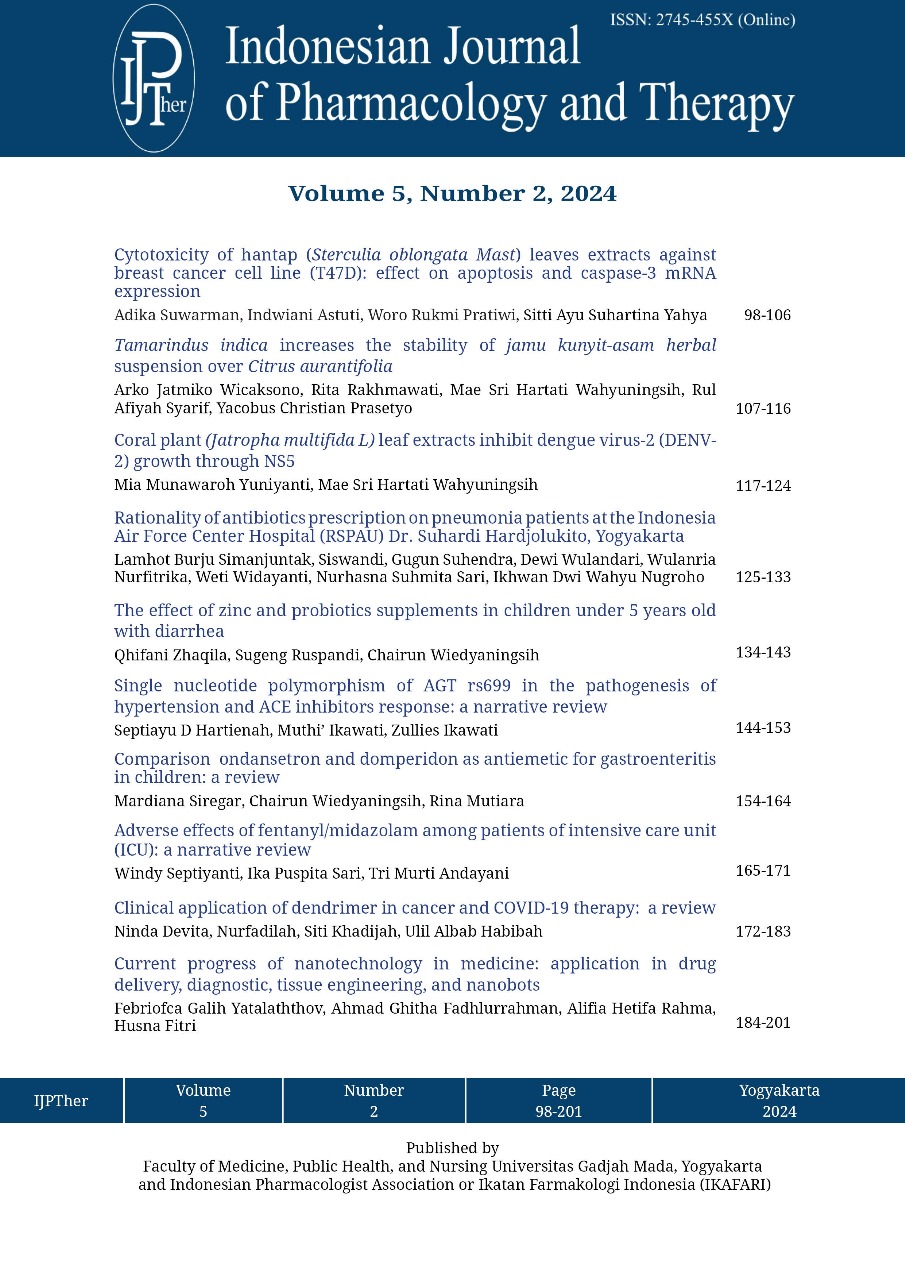The effect of zinc and probiotics supplements in children under 5 years old with diarrhea
Abstract
The 2020 Indonesian Health Profile states that diarrhea is an endemic disease that has the potential to cause extraordinary events. Diarrhea is still one of the contributors to death in Indonesia, especially in children under 5 years old. This study aimed to evaluate the use of zinc and probiotic supplementation on the length of stay (LoS) of patients under 5 years old with diarrhea. It was an observational study using medical records of patients under 5 years old with diarrhea at the Academic Hospital, UGM Yogyakarta in the period of 2021 to 2022. Patient characteristics, including use and medications such as zinc supplementation and probiotics, as well as clinical outcomes including LoS were obtained from 100 medical records. Data were analyzed using chi square from Microsoft Excel 365 & Statistical Program for Social Science (SPSS) with a 95% confidence level (p<0.05). The majority of patients were male (61%) with age range 12-23 mo (47%), 3-4 times frequency of diarrhea (69%), dehydration mild-moderate (89%), and acute diarrhea (96%). The treatment of diarrhea was antidiarrheal (44.81%), fluid rehydration (32.55%), and antibiotics (22.64%). Most patients left the hospital in an improved condition and were allowed to go home (92%). There is a significant relationship between the use of zinc, probiotics, and a combination of zinc and probiotics on LoS.
References
World Health Organization (WHO). Diarrhoeal disease. [cited 2023 Oct 27]. https://www.who.int/news-room/ fact-sheets/detail/diarrhoeal-disease
Kelly L, Jenkins H, Whyte L. Pathophysiology of diarrhoea. Paediatr Child Heal 2018; 28(11):520-6.
https://doi.org/10.1016/j.paed.2018.09.002
Ministry of Health Republic od Indonesia. Profil Kesehatan Indonesia 2020. https://www.kemkes.go.id/id/profilkesehatan- indonesia-2020
DIY DK. Profil Kesehatan DIY Tahun 2020.
World Health Organization (WHO). Diarrhoea [cited 2023 Oct 27]. https://www.who.int/health-topics/ diarrhoea#tab=tab_3
Kementerian Kesehatan RI. Diare, tanda gejala dan cara mengatasinya. [cited 2023 Oct 27]. https://yankes.kemkes.go.id/view_ artikel/737/diare-tanda-gejala-dancara- mengatasinya
Lamberti LM, Walker CLF, Chan KY, Jian WY, Black RE. Oral zinc supplementation for the treatment of acute diarrhea in children: a systematic review and meta-analysis. Nutrients 2013; 5(11):4715-40.
https://doi.org/10.3390/nu5114715
Guarino A, Guandalini S, Vecchio A Lo. Probiotics for prevention and treatment of diarrhea. J Clin Gastroenterol 2015; 49:S37-45.
https://doi.org/10.1097/MCG.0000000000000349
Cruchet S, Furnes R, Maruy A, Hebel E, Palacios J, Medina F, et al. The Use of probiotics in pediatric gastroenterology: a review of the literature and recommendations by Latin-American Experts. Pediatr Drugs 2015; 17(3):199-216.
https://doi.org/10.1007/s40272-015-0124-6
Huang R, Xing HY, Liu HJ, Chen ZF, Tang BB. Efficacy of probiotics in the treatment of acute diarrhea in children: a systematic review and meta-analysis of clinical trials. Transl Pediatr 2021; 10(12):3248-60.
https://doi.org/10.21037/tp-21-511
Lwanga S, Kaggwa, Lemeshow S. Sample size determination in health studies: a practical manual. Geneva: World Health Organization 1991; viii:80. https://tbrieder.org/publications/ b o o k s _ e n g l i s h / l e m e s how_ samplesize.pdf
Ganiswara. Farmakologi dan terapi. Departeman Farmakologi dan Terapeutik FKUI. UI Press; 1995. 831p.
Yusuf S. Profil diare di ruang rawat inap anak. Sari Pediatr 2016; 13(4):265.
https://doi.org/10.14238/sp13.4.2011.265-70
Santika NKA, Efendi F, Rachmawati PD, Has EMM, Kusnanto K, Astutik E. Determinants of diarrhea among children under two years old in Indonesia. Child Youth Serv Rev 2020; 111:104838.
https://doi.org/10.1016/j.childyouth.2020.104838
Gedamu G, Kumie A, Haftu D. Magnitude and associated factors of diarrhea among under five children in Farta Wereda, North West Ethiopia. Qual Prim Care 2017; 25(4):199207.
Anggraeni R, Aljaberi MAA, Nisha Nambiar N, Sansuwito T Bin, Wati NL. The relationship of supplementary feeding, breast milk (MP-ASI) to infants with the event of diarrhea. Int J Nurs Inf 2022;1(1):1-9. https://doi.org/10.53730/ijhs.v6nS4.10072
https://doi.org/10.58418/ijni.v1i1.9
Sanders ME, Guarner F, Guerrant R, Holt PR, Quigley EMM, Sartor RB, et al. An update on the use and investigation of probiotics in health and disease. Gut 2013; 62(5):787-96.
https://doi.org/10.1136/gutjnl-2012-302504
Wilkins T, Sequoia J. Probiotics for gastrointestinal conditions: a summary of the evidence. Am Fam Physician 2017; 96(3):170-8.
Hoque KM, Binder HJ. Zinc in the treatment of acute diarrhea: current status and assessment. Gastroenterology 2006; 130(7):2201-5.
https://doi.org/10.1053/j.gastro.2006.02.062
Qadir MI, Arshad A, Ahmad B. Zinc: Role in the management of diarrhea and cholera. World J Clin Cases 2013; 1(4):140-2.
https://doi.org/10.12998/wjcc.v1.i4.140
Kotwani A, Chaudhury RR, Holloway K. Antibiotic-prescribing practices of primary care prescribers for acute diarrhea in New Delhi, India. Value Heal 2012; 15(1 Suppl.):S116-9.
https://doi.org/10.1016/j.jval.2011.11.008
Rokhmah NN, Manuel YGP, Putri Kusuma EN, Nurdin NM. The rationality of antibiotics use on acute diarrhea to pediatric inpatients in the Fatmawati Hospital for 2018- 2019 Period. J Farm Galen (Galenika J Pharmacy) 2022; 8(1):10-21.



